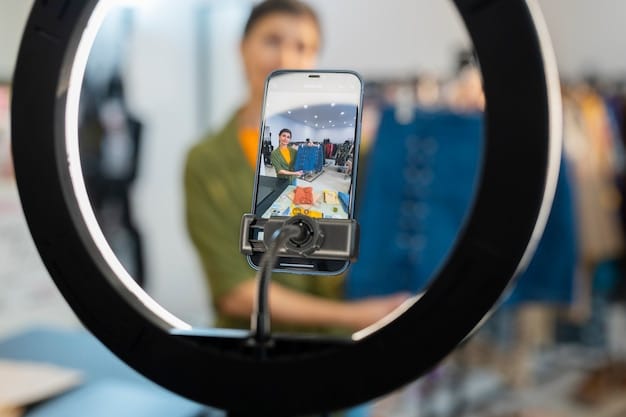Network TV & Influencers: Boosting Viewership with Social Media Stars

Network TV’s Collaboration with Influencers: Can Social Media Stars Drive Viewership to Traditional Broadcasts? explores how network television is partnering with social media influencers to attract younger audiences and revitalize viewership in an increasingly digital landscape.
The landscape of television is evolving, and Network TV’s Collaboration with Influencers: Can Social Media Stars Drive Viewership to Traditional Broadcasts? is becoming an increasingly vital strategy for survival and growth in the digital age.
The Shifting Sands of TV Viewership
The way audiences consume television has undergone a seismic shift. No longer are viewers tethered to scheduled broadcasts; instead, streaming services and on-demand content dominate the entertainment landscape.
This change presents a significant challenge for traditional network television, which relies on consistent viewership for advertising revenue and overall sustainability.

The Digital Disconnect
Younger demographics, in particular, have largely abandoned traditional TV in favor of online platforms. This trend is driven by factors such as the convenience of on-demand viewing, the accessibility of mobile devices, and the allure of personalized content.
Network TV faces an urgent need to bridge this digital disconnect and recapture the attention of younger viewers.
- Streaming Surge: The rise of streaming services like Netflix and Hulu directly competes with traditional network TV.
- On-Demand Appeal: Millennials and Gen Z prefer watching content on their own time, leading to cord-cutting.
- Mobile Dominance: Smartphones and tablets provide convenient access to a vast array of online entertainment.
To adapt to this shifting landscape, networks must explore innovative strategies for reaching and engaging with their target audiences.
The Rise of Influencer Marketing
Influencer marketing has emerged as a powerful tool for brands to connect with consumers in an authentic and engaging way. By partnering with social media influencers who have built a loyal following, brands can tap into a ready-made audience and leverage their credibility to promote products or services.
This approach offers a promising avenue for network television to revitalize its reach and relevance.

Why Influencers Matter
Influencers possess a unique ability to connect with their audience on a personal level. They are seen as authentic and relatable, which allows them to build trust and influence purchasing decisions.
For network TV, this presents an opportunity to leverage the influencer’s reach and credibility to drive tune-in and boost viewership.
Key Benefits of Influencer Marketing
- Authentic Engagement: Influencers connect with their audience in a genuine way, fostering trust and loyalty.
- Targeted Reach: Influencers have built-in audiences, allowing networks to reach specific demographics effectively.
- Brand Awareness: Collaborations can significantly increase awareness of network TV shows and programming.
By strategically aligning with influencers, network television can gain access to new audiences and enhance its brand image.
Synergy in Strategy: How Networks are Teaming Up with Influencers
Network TV is increasingly recognizing the potential of influencer collaborations. By integrating social media stars into their marketing campaigns, networks aim to generate buzz, attract new viewers, and drive tune-in for their shows.
Numerous strategies are being deployed to create a win-win situation for both the networks and influencers.
Behind-the-Scenes Content
One common approach is to feature influencers in behind-the-scenes content, giving viewers a glimpse into the making of their favorite shows. This type of content can generate excitement and anticipation, encouraging viewers to tune in on premiere night.
This strategy creates a sense of exclusivity providing a deeper connection to the show.
Cameos and Guest Appearances
Another effective strategy involves inviting influencers to make cameos or guest appearances on network TV shows. This can be a highly engaging way to integrate influencers into the narrative and attract their followers to watch the show.
The appearance of a well-known influencer can result in a significant spike in ratings.
Measuring Success: Tracking the Impact of Influencer Campaigns
To determine the effectiveness of influencer collaborations, networks must carefully track key performance indicators (KPIs). These metrics can provide valuable insights into the impact of influencer campaigns on viewership, engagement, and brand awareness.
Data-driven analysis is vital for optimizing future influencer strategies.
Key Performance Indicators
Important KPIs to track include tune-in rates, social media engagement (likes, shares, comments), website traffic, and overall brand sentiment. These metrics can help networks understand how influencer campaigns are resonating with their target audience.
Tracking these metrics provides a quantifiable measure of success.
Attribution Modeling
- Click-Through Rates: Measuring the percentage of users who click on links shared by influencers.
- Conversion Rates: Tracking how many viewers tune in after seeing influencer promotions.
- Social Media Mentions: Monitoring the increase in mentions of the TV show or network during and after the campaign.
By using attribution modeling, networks can accurately assess the contribution of influencer marketing to their overall marketing efforts.
Potential Pitfalls: Authenticity and Audience Alignment
While influencer marketing offers significant opportunities for network TV, it also comes with potential pitfalls. One of the biggest challenges is maintaining authenticity. Audiences are increasingly savvy and can quickly detect inauthentic partnerships.
Misalignment betwen the influencer and the show can cause audiences to question the partnerships value.
The Importance of Authenticity
To ensure credibility with the audience, networks must carefully vet influencers and ensure that their values align with the show’s brand. The partnership should feel natural and organic, rather than forced or contrived.
When authenticity is preserved, a partnership feels sincere.
Audience Engagement
Networks must also consider the influencer’s audience demographics. The influencer’s audience should align with the network’s target audience to ensure that the collaboration is effective.
Aligning the audience with the influencer’s base can significantly increase conversions.
Navigating Potential Risks
- Backlash: Partnering with an influencer who has a controversial history can damage the network’s reputation.
- Inauthentic Content: Forced or unnatural collaborations can alienate both the influencer’s followers and the show’s viewers.
- Misalignment: Partnering with an influencer whose audience doesn’t match the show’s target demographic can result in wasted resources.
Careful planning and execution are essential to navigating the potential risks of influencer marketing.
Future Trends: The Evolution of Network TV and Influencer Collaborations
The collaboration between network TV and social media influencers is likely to evolve in the coming years. As technology advances and audience preferences shift, networks and influencers will need to adapt their strategies to stay ahead of the curve.
The merging of traditional and digital media offers opportunities for both sectors.
Virtual Reality and Augmented Reality
Virtual reality (VR) and augmented reality (AR) could play a larger role in influencer marketing campaigns. Networks can collaborate with influencers to create immersive experiences that allow viewers to interact with their favorite shows in new and exciting ways.
For example networks could launch AR filters that correlate with the show’s narrative.
Personalized Content
The use of personalized content is also expected to increase. Networks can leverage data to tailor influencer content to individual viewers’ preferences, making the collaborations more relevant and engaging.
This strategy ensures that viewers receive the right recommendations.
The Rise of Micro-Influencers
- Local Reach: Focusing on influencers with smaller, more engaged audiences can lead to higher conversion rates.
- Higher Engagement Rates: Micro-influencers often have a closer relationship with their followers.
- Community Building: Smaller influencers can foster a sense of community around a TV show.
By embracing these future trends, network TV can continue to leverage the power of influencer marketing to drive viewership and thrive in the digital age.
| Key Point | Brief Description |
|---|---|
| 🚀 Shifting Viewership | TV viewership is declining, especially among younger demographics due to streaming and on-demand content. |
| 🌟 Influencer Appeal | Influencers offer authentic engagement, targeted reach, and increased brand awareness for networks. |
| 🤝 Strategic Synergy | Networks use behind-the-scenes content and cameos to integrate influencers, boosting tune-in rates. |
| ⚠️ Potential Risks | Authenticity and audience alignment are crucial to avoid backlash and ensure effective influencer partnerships. |
FAQ
▼
Viewership numbers are declining as younger audiences switch to streaming services for on-demand content, offering greater convenience and personalized entertainment.
▼
Influencers help by promoting shows to their followers, creating buzz, and driving tune-in through authentic and engaging content.
▼
Successful strategies include featuring influencers in promotions, behind-the-scenes content, and making guest appearances in episodes. These strategies allow networks to reach the influencer’s audiences.
▼
Risks include inauthentic partnerships that alienate viewers. Controversies relating to influencers can also impact the brand negatively. Additionally, audience misalignment should be avoided.
▼
The future involves virtual reality, augmented reality, personalized content, and micro-influencers to connect with viewers through immersive and tailored experiences.
Conclusion
In conclusion, the collaboration between network TV and social media influencers represents a promising strategy for revitalizing viewership and engaging with audiences in the digital age. While challenges exist, careful planning, authentic partnerships, and data-driven analysis can unlock the full potential of influencer marketing and ensure a sustainable future for network television.





